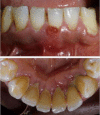Characteristics of inflammation common to both diabetes and periodontitis: are predictive diagnosis and targeted preventive measures possible?
- PMID: 23199045
- PMCID: PMC3405308
- DOI: 10.1007/s13167-010-0016-3
Characteristics of inflammation common to both diabetes and periodontitis: are predictive diagnosis and targeted preventive measures possible?
Abstract
Diabetes and periodontitis are chronic inflammatory disorders that contribute to each others' severity and worsen each others' prognosis. Studies have shown that patients with diabetes are at increased risk of developing periodontitis, and that diabetics with untreated periodontitis have more difficulty controlling serum glucose. Periodontal treatment that reduces gingival inflammation aids in the control of hyperglycemia. Periodontitis is accompanied by gingival bleeding and the production of an inflammatory exudate termed gingival crevicular fluid (GCF) that arises from the inflamed gingival tissues surrounding the teeth. GCF contains byproducts of connective tissue degradation, enzymes from host and bacterial cells, cytokines and other inflammatory mediators, and has been studied for screening blood glucose and for biomarkers of both diabetes and periodontitis. This review focuses on the inter-relationship between diabetes and periodontitis and the biomarkers common to both these diseases that may enable earlier detection, targeted preventive measures and individualized therapeutic intervention of these chronic conditions.
Figures









Similar articles
-
Gingival crevicular fluid levels of interleukin-1beta and glycemic control in patients with chronic periodontitis and type 2 diabetes.J Periodontol. 2004 Sep;75(9):1203-8. doi: 10.1902/jop.2004.75.9.1203. J Periodontol. 2004. PMID: 15515334
-
PGE2, IL-1 beta, and TNF-alpha responses in diabetics as modifiers of periodontal disease expression.Ann Periodontol. 1998 Jul;3(1):40-50. doi: 10.1902/annals.1998.3.1.40. Ann Periodontol. 1998. PMID: 9722689
-
Is the severity of periodontitis related to gingival crevicular fluid and serum high-sensitivity C-reactive protein concentrations?Clin Lab. 2014;60(10):1653-8. doi: 10.7754/clin.lab.2014.131217. Clin Lab. 2014. PMID: 25651710
-
Analysis of gingival crevicular fluid as applied to the diagnosis of oral and systemic diseases.Ann N Y Acad Sci. 2007 Mar;1098:216-29. doi: 10.1196/annals.1384.027. Ann N Y Acad Sci. 2007. PMID: 17435131 Review.
-
[Gingival crevicular fluid in the diagnosis of periodontal and systemic diseases].Srp Arh Celok Lek. 2009 May-Jun;137(5-6):298-303. doi: 10.2298/sarh0906298c. Srp Arh Celok Lek. 2009. PMID: 19594076 Review. Serbian.
Cited by
-
Is There Any Association Between Neurodegenerative Diseases and Periodontitis? A Systematic Review.Front Aging Neurosci. 2021 May 24;13:651437. doi: 10.3389/fnagi.2021.651437. eCollection 2021. Front Aging Neurosci. 2021. PMID: 34108875 Free PMC article.
-
The status of glucocorticoid-induced leucine zipper protein in the salivary glands in Sjögren's syndrome: predictive and prognostic potentials.EPMA J. 2016 Feb 5;7(1):3. doi: 10.1186/s13167-016-0052-8. eCollection 2015. EPMA J. 2016. PMID: 26855686 Free PMC article.
-
A brief review of vitamin D as a potential target for the regulation of blood glucose and inflammation in diabetes-associated periodontitis.Mol Cell Biochem. 2022 Sep;477(9):2257-2268. doi: 10.1007/s11010-022-04445-w. Epub 2022 Apr 27. Mol Cell Biochem. 2022. PMID: 35478388 Review.
-
Impact of Chronic Periodontitis on Levels of Glucoregulatory Biomarkers in Gingival Crevicular Fluid of Adults with and without Type 2 Diabetes.PLoS One. 2015 May 20;10(5):e0127660. doi: 10.1371/journal.pone.0127660. eCollection 2015. PLoS One. 2015. PMID: 25993052 Free PMC article.
-
Comparison of the number of gingival blood vessels between type 2 diabetes mellitus and chronic periodontitis patients: An immunohistological study.J Indian Soc Periodontol. 2015 Mar-Apr;19(2):164-8. doi: 10.4103/0972-124X.152105. J Indian Soc Periodontol. 2015. PMID: 26015666 Free PMC article.
References
-
- Mealey B, Rees T, Rose L. Systemic factors impacting the periodontium. In: Rose L, Mealey B, editors. Periodontics medicine, surgery, and implants. St. Louis: Elsevier Mosby; 2004.
-
- Loe H. Periodontal disease: The sixth complication of diabetes mellitus. Diabetes Care. 1993;16(Suppl 1):329–34. - PubMed
-
- Papapanou P. Periodontal diseases: epidemiology. Ann Periodontol. 1996;1:1–36. - PubMed
LinkOut - more resources
Full Text Sources

